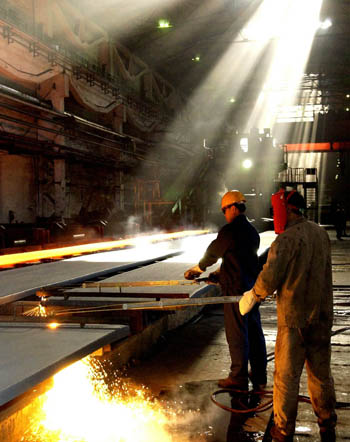Q: It has been reported that China's SOEs, which use
half of the State's fixed assets and 60 percent of bank loans,
produce only one third of total industrial output. Is this true?
China has adopted the SOE reform since 1986. How are the reforms
being carried out and to what effect?
A: It is well known that SOEs have played a pivotal role in the
national economy since the founding of the People's Republic of
China. SOEs take most of the credit in China's transformation from
an impoverished semi-feudalist, semi-colonial country into a
socialist county with an independent and complete national economic
system.
When China adopted reform and opening up in 1978, 77.6 percent
of the industrial output value came from SOEs. As reform continues,
businesses of other ownerships, including the collective companies,
private companies and foreign companies, have been greatly
encouraged by the government, leading to the scaling back of SOEs'
proportion of the country's total industrial output.
?
The low efficiency of SOEs is an issue of international concern. It
also exists in China. In the process of China's reform and opening
up, the low efficiency of SOEs have stood out more prominently.
This explains why SOEs use a majority of the State's fixed assets
and bank loans while creating only one-third of the industrial
output. This also explains why China has attached great importance
to the reform of SOEs, regarding it as a vital component of the
entire economic reform.
?
Reform of SOEs began by focusing on increasing efficiency. Measures
included loosening government control and implementing the contract
responsibility and leasehold systems.
Reform in setting up the shareholding system began in the 1980s,
though most SOEs did not the concept of property rights at that
time. Even those regarding themselves as shareholding companies
failed to match their name, especially if the listed company was
solely founded by a SOE.
Except for the change of company's name, the internal structure
remained the same. As a result, nobody was responsible for the
losses or insolvency incurred by operational misconduct or for the
draining of State assets caused by wrong decisions. Under such
circumstances, the operation of SOEs experienced no thorough
transformation and non-performing assets kept climbing.
In 1993, China decided to reform its SOEs by establishing a
modern corporate system and encouraging foreign and private
investment to participate in SOEs' management and development. As a
result, SOEs were transformed into mixed ownership companies with
different types of investors that could restrict and balance each
other. Experience from property rights reforms of SOEs show that
since someone is responsible for assets losses, companies are very
prudent in making operation and investment decisions. Consequently,
the operation of these companies has improved to certain
degree.
Since 2000, the number of SOEs has dropped, but the quality of
assets, their competitiveness and efficiency have all been
enhanced. The State economy has continued its control over
industries and fields that are vital to the national economy and
maintained its dominant role in economic development.
According to statistics, the number of SOEs and state-controlled
companies decreased from 238,000 in 1998 to 150,000 in 2003. In the
same period, however, their total profits jumped from 21.4 billion
yuan (US$2.58 billion) to 495.1 billion yuan (US$59.65 billion),
total net assets from 5.2 trillion yuan (US$626.5 billion) to 8.4
trillion yuan (US$1.01 trillion), and the rate of return on
State-owned assets reached 5.9 percent.
?
Every reform has its price. And the reform of Chinese SOEs is no
exception. Recently, the phenomenon of State assets being drained
in the process of reform and transfer of property rights has
emerged. This was caused by defects in the reforms.
Determined by the special situation of SOEs in China, and
without prior experience to draw from, the reform can't be
completed overnight. Currently, the modern corporate system has
just started to be implemented in China's SOEs and there is a long
way to go before a mature system is established. Reform of the
State assets management mechanisms is still at its initial stage,
leaving some deep conflicts and problems to be solved only when the
reform deepens.

Through a long period after the
founding of the People's Republic of China in 1949, state-owned
enterprises were a pillar of national economy. Pictured is a
production line in the Benxi Steel and Iron Corp. in Liaoning
Province.